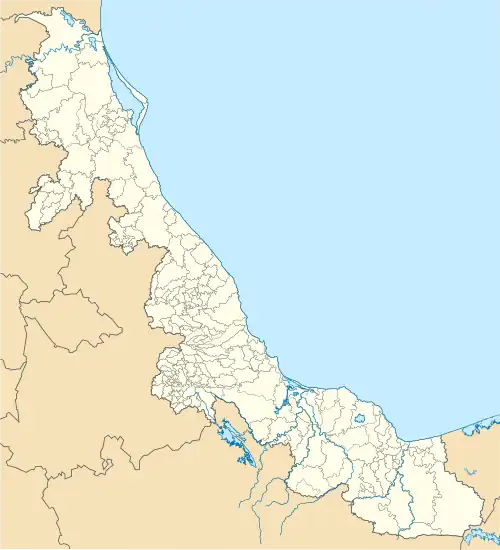Veracruz International Airport
Veracruz International Airport (Spanish: Aeropuerto Internacional de Veracruz Heriberto Jara); officially Aeropuerto Internacional Heriberto Jara (General Heriberto Jara International Airport) (IATA: VER, ICAO: MMVR) is an international airport located in Veracruz, Mexico. It handles national and international air traffic for the Metropolitan Area of Veracruz and a significant portion of the State of Veracruz, including the metropolitan areas of Córdoba, Orizaba, and Xalapa.
Veracruz International Airport Aeropuerto Internacional de Veracruz | |||||||||||||||
|---|---|---|---|---|---|---|---|---|---|---|---|---|---|---|---|
.jpg.webp) | |||||||||||||||
| Summary | |||||||||||||||
| Airport type | Public/Military | ||||||||||||||
| Operator | Grupo Aeroportuario del Sureste | ||||||||||||||
| Serves | Veracruz, Veracruz | ||||||||||||||
| Elevation AMSL | 27 m / 90 ft | ||||||||||||||
| Coordinates | 19°08′45″N 96°11′14″W | ||||||||||||||
| Map | |||||||||||||||
 VER Location of airport in Veracruz  VER VER (Mexico) | |||||||||||||||
| Runways | |||||||||||||||
| |||||||||||||||
| Statistics (2022) | |||||||||||||||
| |||||||||||||||
Source: Grupo Aeroportuario del Sureste[1] | |||||||||||||||


It ranks as the third-busiest airport in southeastern Mexico and the 16th busiest in the country. In 2021, the airport handled 1,103,460 passengers, and in 2022, it served 1,333,578 passengers, according to Grupo Aeroportuario del Sureste.[2] The airport is named in honor of General Heriberto Jara, a Constituent Deputy and Governor of Veracruz from 1924 to 1927.
General Information
The airport is situated on the outskirts of the city of Veracruz, in an area known as "Las Bajadas." It is operated by the Grupo Aeroportuario del Sureste (ASUR), and features a terminal covering 16,000 square meters, with the capacity to accommodate up to 10 aircraft. It boasts a 7,874-foot runway suitable for aircraft such as the Boeing 737 and Airbus A320.
The ground floor houses a check-in area with 38 counters and six kiosks, as well as the arrivals area with customs and immigration facilities and four baggage claim carousels. Additionally, it includes taxi stands and car rental counters. On the upper floor, there is a security checkpoint and a departure area equipped with a food court, duty-free shop, a VIP lounge, and concourse A, with four gates equipped with jet bridges. Concourse A is primarily used by Aeromexico, Viva Aerobus, and United Airlines. At the northern end of the building, a set of stairs leads back to the ground floor where Concourse B (Gates B1-8) is located. Concourse B is primarily used by Aerus, TAR, Viva Aerobus, and Volaris.
The terminal does not have public transportation service to the city of Veracruz; however, it does offer ADO bus services to nearby cities like Xalapa. The parking facility provides both short-term and long-term parking spaces.
Las Bajadas Naval Air Base
Veracruz Airport shares runway 01/19 with Las Bajadas Naval Air Base, also known as Naval Air Base of Veracruz (Spanish: Base Aeronaval de Veracruz) (BASANVER). It is the largest and oldest Naval Air Base in Mexico. It controls operations on the Gulf Coast of Mexico.[3]
Las Bajadas Air Base hosts the following units:
- 1st Maritime Patrol Naval Air Squad – operating CASA C-212PM
- 1st Early Warning and Reconnaissance Naval Air Squad – operating E-2C Hawkeye 2000
- Naval Aviation School – operating MD 500, Robinson R22, Schweizer 300, Zlín Z 42
History
Veracruz Airport was constructed in 1942 in an area known as "Las Bajadas." The construction was carried out by Compañía Mexicana de Aviación. However, the financial resources were provided by the United States government through Pan American Airlines, and funded by special allocations authorized by the U.S. Congress. World War II saw the creation of the Naval Aviation school in 1943 at Las Bajadas, using aircraft that had belonged to the Mexican Air Force. Improvements were made in 1956, including the construction of fuel storage facilities.
In 1964, on the brink of bankruptcy, Mexicana de Aviación sold the airport to the Mexican government. Between 1965 and 1970, the airport was completely reconstructed on the site of the previous one. Adjacent lands were acquired to meet the requirements of a new airport project, which included runways, taxiways, commercial and general aviation platforms, a control tower, a passenger terminal, parking lots, an access road, a machinery room, and a fuel station. Additionally, air conditioning equipment, high-intensity lights, and visual aids were installed. For the pavement of both runways, a mixed-type experiment was conducted, using hydraulic concrete in the longitudinal center section and flexible pavement in the immediate lateral areas. In 1974 the Naval Air Station of Veracruz was established taking over the old airport facilities.[4]
In the 1990s, the airport became part of the Grupo Aeroportuario del Sureste, the first to be concessioned to private initiative. It includes Cancún, Cozumel, Huatulco, Mérida, Minatitlán, Oaxaca, Tapachula, Villahermosa, and Veracruz airports. In 1999 the Mexican Navy started a programme to build kit-planes and light helicopters at the Naval Air Base. Between 2014 and 2016 the passenger terminal underwent a complete modernization and expansion. Gates in Concourse A were equipped with jetbridges and Concourse B was built to accommodate more passengers.
Facilities


.jpg.webp)
.jpg.webp)
.jpg.webp)

_at_Veracruz_International_Airport.jpg.webp)


- Number of gates: 11
- Contact positions: 11
- Number of jetways: 3
- Number of baggage claiming carousels: 6 (4 domestic, 2 international)
- Customs (Arrivals area)
- Taxi & car rentals (Arrivals area)
- Duty Free
- Caral VIP Lounge
- Parking area
Airlines and destinations
Passenger
| Airlines | Destinations |
|---|---|
| Aeroméxico | Mexico City |
| Aeroméxico Connect | Mexico City, Mexico City–AIFA |
| Aerus | Tampico, Villahermosa |
| TAR | Ciudad del Carmen, Monterrey, Tampico |
| United Airlines | Houston–Intercontinental (begins 29 October 2023) |
| United Express | Houston–Intercontinental (ends 28 October 2023) |
| Viva Aerobus | Cancún, Guadalajara, Mérida, Mexico City, Mexico City–AIFA (begins 8 January 2024),[5] Monterrey, Reynosa |
| Volaris | Cancún (resumes 1 November 2023), Guadalajara, León/El Bajío, Tijuana |
Destinations map
| Destinations map |
|---|
 Veracruz Domestic destinations from Veracruz International Airport Red = Year-round destination Green = Seasonal destination Italic = Suspended destination |
International destinations from Veracruz International Airport Red = Year-round destination |
Statistics


Busiest routes
| Rank | City | Passengers | Ranking | Airline |
|---|---|---|---|---|
| 1 | 227,850 | Aeromar, Aeroméxico, Aeroméxico Connect, VivaAerobús | ||
| 2 | 117,576 | TAR, VivaAerobús | ||
| 3 | 115,256 | VivaAerobús | ||
| 4 | 91,324 | VivaAerobús, Volaris | ||
| 5 | 36,476 | VivaAerobús | ||
| 6 | 26,121 | VivaAerobús | ||
| 7 | 22,401 | United Express | ||
| 8 | 20,822 | Volaris | ||
| 9 | 5,002 | Aeroméxico Connect | ||
| 10 | 2,868 | TAR |
Accidents and incidents
On 2 April 1981, Douglas C-47A N258M of Sky Train Air was written off in an accident while taxiing.[7]
References
- "Passenger's Traffic" (in Spanish). ASUR. Retrieved 11 January 2023.
- "Our airports".
- "La Historia de la Aeronáutica Naval en el Museo Naval México / Veracruz" (in Spanish).
- "Aeropuertos" (PDF) (in Spanish).
- "Viva Aerobus Bets Big on AIFA: 17 New Routes". Aviacionline. September 2023. Retrieved 28 September 2023.
- "Estadística operacional por origen-destino / Traffic Statistics by City Pairs" (in Spanish). Agencia Federal de Aviación Civil. January 2023. Retrieved 26 January 2023.
- "N258M Accident description". Aviation Safety Network. Retrieved 24 July 2010.
